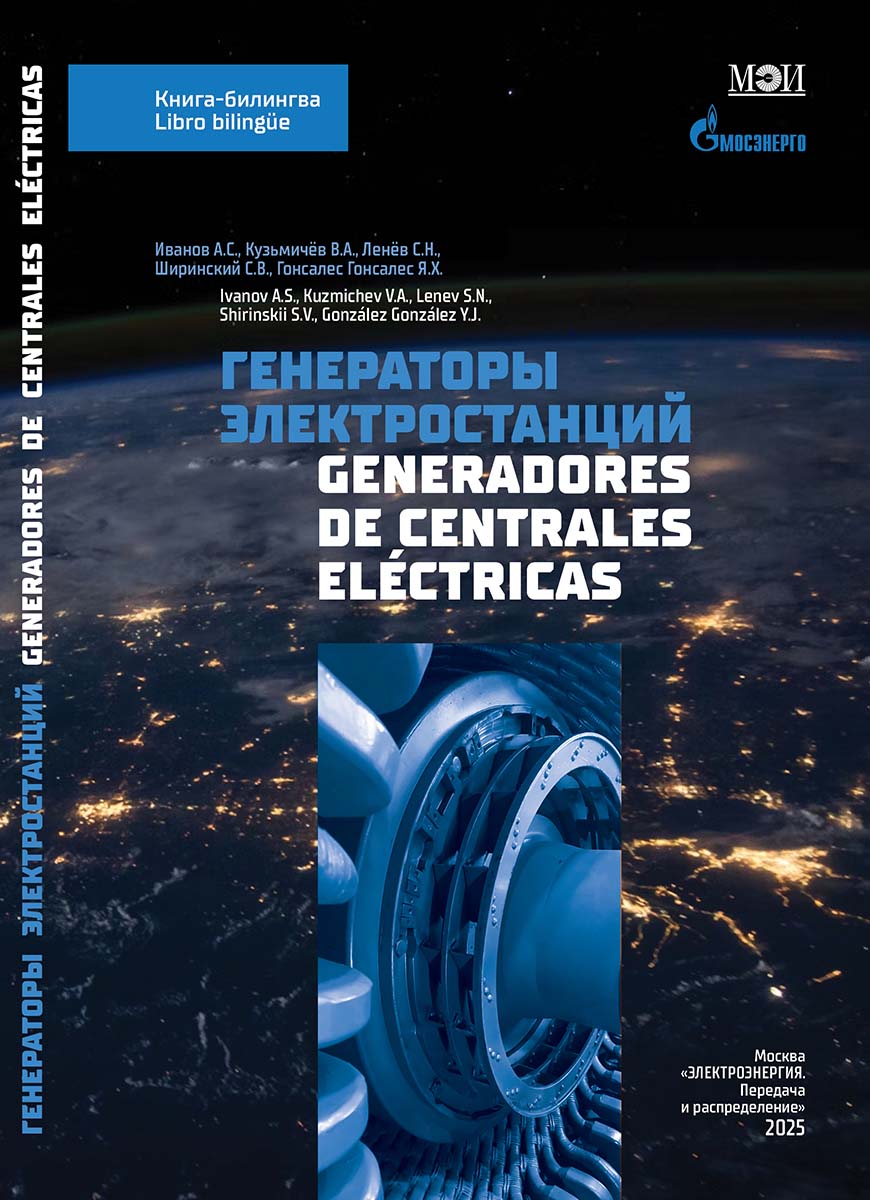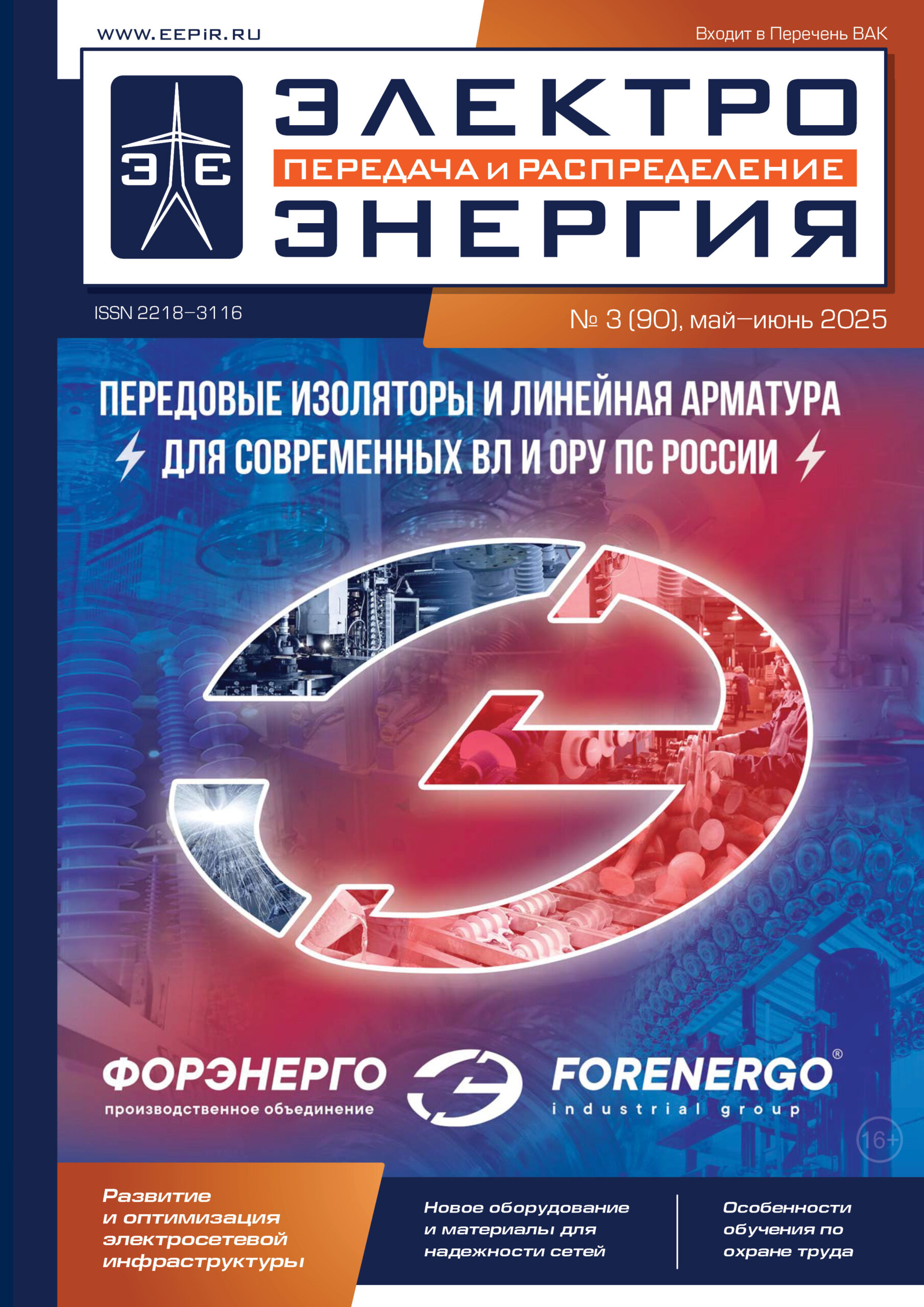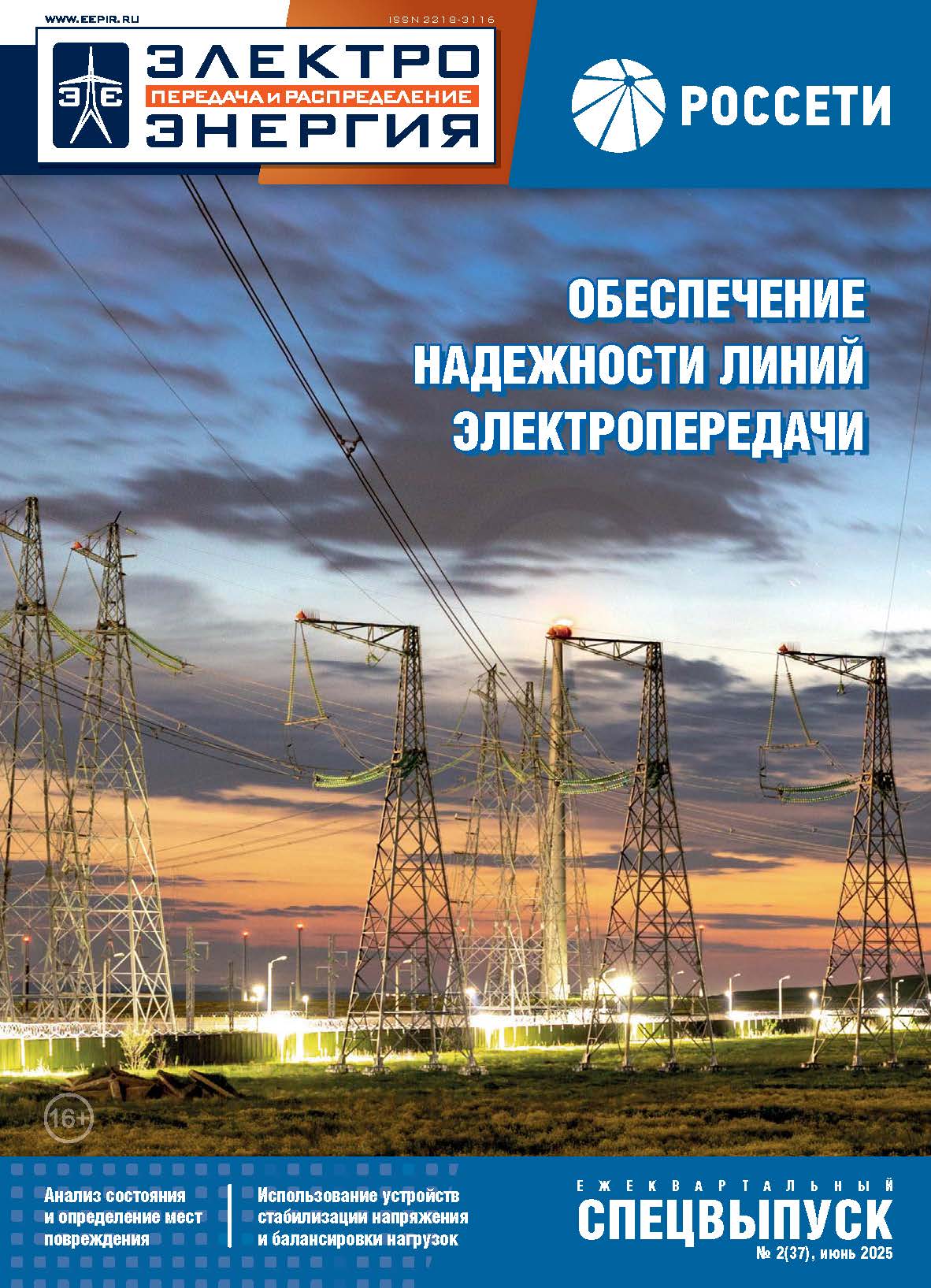
20 ноября 2023
АНОНС «ЭЛЕКТРОЭНЕРГИЯ. Передача и распределение» № 6(81), ноябрь-декабрь 2023
15 статей в открытом доступе
Оформить подпискуОформите подписку, чтобы получить доступ ко всем материалам выпуска, или купите нужную статью отдельно
Уже есть подписка? Тогда авторизуйтесь.
СОБЫТИЯ
АКТУАЛЬНОЕ ИНТЕРВЬЮ
ЦИФРОВАЯ ТРАНСФОРМАЦИЯ
УПРАВЛЕНИЕ СЕТЯМИ
УЧЕТ ЭЛЕКТРОЭНЕРГИИ
ИМПОРТОЗАМЕЩЕНИЕ
КАЧЕСТВО ЭЛЕКТРОЭНЕРГИИ
КАЧЕСТВО ЭЛЕКТРОЭНЕРГИИ
КАЧЕСТВО ЭЛЕКТРОЭНЕРГИИ
КАЧЕСТВО ЭЛЕКТРОЭНЕРГИИ
ВОЗОБНОВЛЯЕМАЯ ЭНЕРГИЯ
НАКОПИТЕЛИ ЭЛЕКТРОЭНЕРГИИ
НАКОПИТЕЛИ ЭЛЕКТРОЭНЕРГИИ
УДК 621.311:621.3.072
ЭНЕРГОСНАБЖЕНИЕ
КАБЕЛЬНЫЕ ЛИНИИ
КАБЕЛЬНЫЕ ЛИНИИ
ОБОРУДОВАНИЕ
РЕЛЕЙНАЯ ЗАЩИТА И АВТОМАТИКА
РЕЛЕЙНАЯ ЗАЩИТА И АВТОМАТИКА
РАБОТА ПОД НАПРЯЖЕНИЕМ
ПРОИЗВОДСТВЕННЫЙ ТРАВМАТИЗМ
EVENTS
To Prevent but not to Punish. Review of REW-2023 Session Dedicated to Labor Safety
TOPICAL INTERVIEW
System Solutions for Provision of Labor Safety for Each Employee
Interview with Andrey KOLTSOV, Director General of Engineering Supervision Center, PJSC Rosseti affiliate
DIGITAL TRANSFORMATION
Rosenergoatom Joint-Stock Company: the Experience of Introducing the Common Information Model
JSC UNECO Participation in REW-2023
GRIDS MANAGEMENT
Development and Introduction of a HW/SW Complex for Peak Load Forecasting and Load Curve Management in Operational and Personal Needs Facilities
PJSC Rosseti Centre, a subsidiary of PJSC Rosseti Centre and Volga region – Nizhnovenergo, LLC RENERA, Atom Power Industry Trade JSC
ELECTRIC POWER METERING
Use of AI in the Form of Neural Networks for Off-the-meter Consumption Detection. Experience Feedback of JSC Grid Company
A New Process Level of the Energy Loss Control
MTS Company
IMPORT SUBSTITUTION
A Russian Development – the European Quality
Systême Electric
The Meeting of Chief Power Engineers of Petrochemical Plants and Oil Refineries. Results of the Import Substitution Work in 2023
Domestic Software Solutions for the Power Industry
OOO PARMA
POWER QUALITY
Technologies for Controlling the Operating Modes of Distribution Networks with Asymmetric Loads to Reduce Losses and Improve the Quality of Electrical Energy
Astashev M.G., Panfilov D.I., Chasov A.V. (NRU MPEI, Moscow)
Abstract. The article considers the control of operating modes of distribution electric networks with asymmetric loads as one of the mechanisms for reducing losses and normalizing the quality of electricity in electric power systems. The formalization of the problem of controlling the modes of operation of distribution networks with asymmetric loads based on the method of symmetric components and energy ratios is presented. Various technologies of network operation modes symmetry are considered, including voltage control of network phases, reactive power compensation, redistribution of energy consumption between individual phases of the network, compensation of individual symmetrical components of asymmetric currents and voltages of the network and load. An overview of the technical means implementing such technologies and allowing real-time influence on the operating modes of the phases of the distribution network is given. An example of assessing the impact of various technical means on reducing energy losses is given.
Keywords: asymmetric load, improvement of electric power quality indicators, control technologies of distribution net- works, method of symmetrical components, symmetry of operating modes, reactive power compensation, stabilization of network phase voltages
On the Effect of Voltage Failures and Interruptions on the Modes of Operation of Industrial Power Supply Systems
Sevostyanov A.A. (NSTU, Nizhny Novgorod)
Abstract. About 90% of distortions involving power quality analysis value are caused by the operation of industrial power supply systems. This is due to the fact that existing approaches to rationing, monitoring and quality management of electricity do not take into account the specifics of emerging damages in various industries and give large errors. Thus, not only do gradual changes of voltage and harmonic distortions appear, but also disturbances caused by voltage dips and interruptions, which lead to technological equipment malfunctioning as well as serious damage to power quality. However, despite the possible damage from voltage dips and short interruptions in power supply systems, there is no standardization in power quality requirements, and power quality requirements are often not taken into consideration in the design and operation of power supply systems. On the basis of the research conducted on power quality value and analysis of current regulatory documents, the author of the article feels that it is crucial to take into consideration voltage dips and interruptions in the operation of industrial power supply systems.
Keywords: electricity quality, monitoring, voltage failure, voltage interruption, electromagnetic compatibility
A Method of Electrical Network Nodes Selection for Allocating Devices Mitigated Intermittent Voltage Unbalance
Tulsky V.N., Silaev M.A., Shish K.V., Bordadyn P.A., Shish M.R., Semeshko D.A. (NRU MPEI, Moscow)
Abstract. The work is devoted to intermittent voltages unbalance in electrical networks feeding the traction load. Dynamic modeling of unbalanced modes in a real network fragment in MATLAB Simulink was performed. A method of electrical network nodes selection for allocating devices mitigated intermittent voltage unbalance in a two-way power supply network feeding a section of an electrified railway was proposed. The software based on the method was developed.
Keywords: power quality, intermittent voltage unbalance, electrified railways, compensation of voltage unbalance
The Criterion of Power Losses Caused by Current Asymmetry in Three-Phase Transformers and Four-Wire Lines
Kosoukhov F.D., Epifanov A.P., Vasiliev N.V., Krishtopa N.Yu. (St. Petersburg State Agrarian University), Gorbunov A.O. (Contel LLC), Boroshnin A. A. (Energostroy LLC)
Abstract. The criterion of power losses caused by current asymmetry for three-phase transformers and four-wire lines has been developed. The mathematic expression for the power loss criterion is provided; it is given via symmetric components of three-phase load currents and transformer/line parameters. The experimental research of the power criterion has been carried out on a physical model of a 0,38 kV three-phase four-wire network. Full match of results by the initial formulae and the calculated expression of the power loss criterion has been determined. Power loss criteria for two typical transformers with different wire connections Y/Yн и Y/Zн have been defined experimentally. The criterion of power losses caused by current asymmetry is recommended to be used when developing the methods and the means of minimizing the power losses due to extra losses in 0,38 kV networks and when assessing the technical means intended for minimizing the power losses in electrical networks.
Keywords: power loss criterion, power, electric energy, electric current, voltage, power losses, symmetric current components, physical model, experimental research, three-phase load, electric motors, transformers, measuring tools
RENEWABLE ENERGY
Virtual Inertia Systems: a New Approach to RES Integration into Power Systems
Burmeyster M.V., Berdyshev I.I., Bulatov R.V., Nasyrov R.R. (NRU MPEI, Moscow)
Abstract. The aim of this article is to sum up the available information about the virtual inertia systems. The terminology of power inverters and virtual inertia systems is provided in this article together with the description of worsening of power system stability conditions following the increased share of renewable energy sources (RES) used in generation, the causes of virtual inertia system origination, the classification of inverter types used in solar and wind power plants. The main types of virtual inertia systems and the technological effects achieved by their means are described in the article. The activities of scientific and industrial communities to develop the virtual inertia systems are specified. The pilot projects and application areas of virtual inertia systems are described. Further research areas are defined and the issue of regulatory support of operations is revealed. The conclusions made about the virtual inertia system as an approach to RES integration are given at the end of the article.
Keywords: virtual inertia systems, virtual synchronous machine, virtual synchronous generator, synchroinverter, driven inverters, automatic inverter control system, energy storage systems
ENERGY STORAGES
Estimation of Impact of Energy Storage System Parameters on the Efficiency of Solar-Diesel Complexes with Generation from Renewable Energy Sources
Andreeva K.A., Vas’kov A.G. (NRU MPEI, Moscow)
Abstract. The object of the study is the energy storage system in solar-diesel complexes. The paper considers the development of a mathematical model of the energy storage system, including the choice of a mathematical model of the energy storage system, the development of a program to control the operating modes of the solar-diesel complex, as well as the determination of possible operational limitations of the energy storage system. Experiments are described to investigate the efficiency of energy storage systems in solar-diesel complexes at different parameters. The obtained data are analyzed and recommendations on the choice of parameters of the energy storage system are provided.
Keywords: solar-diesel complex (SDC), energy storage system (ESS), modelling, programming, mode planning
Formation of Requirements for the Main Rarameters of Flywheel Energy Storages
Panteleev V.I., Blinnikov M.E. (Siberian Federal University, Krasnoyarsk)
Abstract. Based on the typical daily demand profile of non-industrial buildings transformer substations, the requirements for energy storage capacity, power and average self-discharge losses of energy storage in relative units of the power of the transformer of transformer substation are formed. A statistical analysis of transformers frequently encountered in terms of power in urban networks of 6-10 kV was carried out and averaged values of the energy intensity of the energy storage system based on flywheel energy storage, power and average self-discharge of a single flywheel storage in absolute units were obtained. The required unit storage capacity and maximum operating speed for load leveling of transformer substations of non-industrial buildings were evaluated.
Keywords: flywheel energy storage, transformer substation, power energy flow, energy storage system, load leveling, energy storage capacity
POWER SUPPLY
Introduction of the Resonance System of Electric Power transmission in Ryazanenergo, a subsidiary of PJSC Rosseti Centre and Volga region
Oryol State Agrarian University, Federal Scientific Agroengineering Center VIM
OVERHEAD TRANSMISSION LINES
Group of Companies ARMATEKH – 25 Years of Growth
Insulator Sets of a New Generation
PO FORENERGO
ENERVIC. Retaining the Quality and Technologies of Ensto in Russia
CABLE LINES
Development of the Reducing Joint for Connection of a 110-220 kV Oil-Filled High-Pressure Cable with a 110-220 kV XLPE Cable
PJSC Rosseti Moscow region, Isolyator Group, JSC VNIIKP
Current-Searching Pipes ProtektorFlex® OMP Designed for Prevention of Cable Failures
ENERGOTEK COMPANY
EQUIPMENT
Turbulence Impact on Operation of Measuring and Indicating Instruments in Oil-Cooling Systems
OOO Cooling Systems
Automatic Circuit-Breaker Series YON from JSC “DKC”
DIAGNOSTICS AND MONITORING
Heat Monitoring as a Method of Technical Diagnosis
ООО SEBA ENGINEERING
RELAY PROTECTION AND AUTOMATION
Prospects for Using of New Types of Current Transformers for Differential Protection for Transformers
Yablokov A.A., Panaschatenko A.V., Tihov E.M. (Ivanovo State Power Engineering University)
Abstract. The article is devoted to the analysis of the problems of operation and the possibilities of improving the methodology for selecting the operation parameters of the longitudinal differential current protection of a power transformer through the use of new types of current transformers (including digital ones). The article presents the results of research on the characteristics of digital transformers. The analysis of these characteristics showed the prospect for improv- ing the methodology for selecting the operation parameters of the dif- ferential protection of the transformer in order to improve the quality of its operation.
Keywords: current transformers, digital transformers, differential protection for transformers
Smart Energy: Present Day
OOO ZapSibNeftekhim
WORK UNDER VOLTAGE
Specific Aspects of Mastering New Types of the Live Line Works at 6/10 kV Installations
JSC Grid Company
Interbranch union RPN – live line works
LABOR PROTECTION
Best Solutions of ALPSAFE for Works at Height Safety
OOO Alptekhnologii
An Innovative Approach to Works at Height Safety Provision
Carabelli S.r.l.
INDUSTRIAL INJURIES
Dynamics of the Work-Related Injuries in Quarter III of 2023
Russian Federal Service for Ecological, Technical and Atomic Supervision; Association “ERA of Russia”





